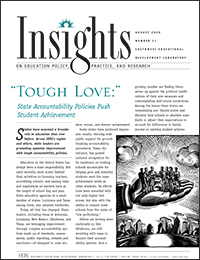Public Reporting
Reporting school and district test scores to the public has become the major tool by which states demonstrate accountability. As of 1999, all states but one reported student achievement results to the public. Of those, 47 provided information at the district level and 41 reported their data at the school level (Council of Chief State School Officers, 1999), typically by using anywhere from four to six levels of proficiency in each subject area, ranging from the best to the worst. These school and district reports generally indicate the percentage of students who have reached each level of proficiency. Because test results remain the dominant means by which policymakers and the press describe the performance of schools, accurate reporting of student and school performance has taken on critical importance in state accountability systems.
Accurate reporting of student and school performance has taken on critical importance in state accountability systems. A major challenge in producing such accountability information is explaining the data in ways that the public can understand.
A major challenge in producing such accountability information is explaining the data in ways that the public can understand (National Research Council, 1999). Student reports are available directly to students and their parents. In general, they provide information on the student’s level of accomplishment in each content area tested and indicate how the student scored with respect to the statewide standards. The reports also describe typical performance at different standard levels so parents will know how to interpret the results.
Other community members interested in education generally get the news about test scores through the media. Good reporting about the quality of schools performs a valuable public service; inaccurate or incomplete reporting can add fuel to already seething controversy. Responsible reporting fully explains test scores and their limitations. It does not oversimplify or delete the very information that helps the public understand the meaning of scores. Nor does it make invalid statistical comparisons, for example, ranking schools that in reality had statistically negligible differences on their test scores.
Communications and public relations are of tremendous importance because the public’s understanding of these technically complex accountability systems will ultimately affect the public’s confidence in them. What is the pedagogical basis of a new assessment strategy? Why is one level of achievement proficient and another not? Why did some schools receive sanctions and others rewards? Why does this testing program need to be revised already? Helping the public understand such issues is groundwork that will sustain commitment and support for an accountability system when some students start to fail or when schools find themselves labeled "unsatisfactory."
Public Reporting in the Region
In Arkansas. By November 15 of each year, every Arkansas school district must report, in a general circulation newspaper in the district, its progress toward accomplishing its program goals, accreditation standards, and proposals to correct deficiencies. Districts also issue school performance reports that are sent to parents by mail and disseminated to the public on the Department of Education’s Web site. Each school is required, at least once a year, to explain its policies, programs, and goals to the community in a public meeting. Arkansas also analyzes and reports assessment data separately for special education students, students who are not proficient in English, and students who frequently move.In Louisiana. The state reports annually on its progress in reaching its 10-year goals. It also publishes report cards for each school. These provide a school performance score, the school’s progress in reaching its growth target, the school’s performance compared to "like" schools, and subgroup performance data such as race, gender, and high-poverty vs. non-poverty student achievement. Data have been made available on the State Department of Education’s Web site.
In New Mexico. Each year, the New Mexico State Department of Education publishes a State Accountability Report. This report contains information on education programs, trends, finances, and student achievement. In addition, the New Mexico legislature passed a key statute in 1997 requiring each school district to publish an annual School District Report Card. It provides school-based data on student achievement, attendance, dropout rate, school safety, and parent and community involvement.
In Oklahoma. The Oklahoma State Department of Education issues district report cards, a report of student test scores, and a reading sufficiency report. The Office of Accountability, also issues reports for the state, districts, and individual schools that describe community characteristics, district educational processes, and student performance. The reports are available on the Web. School-level report cards are also distributed to schools so principals can add their own comments and provide them to parents. District reports are distributed to libraries, a mailing list, and others who request them.
In Texas. The state’s indicator system combines TAAS scores, end-of-course passing rates, attendance, high school completion rates, and other information to assign ratings to each school and district. The state has developed an extensive Web site to disseminate these data. Schools are responsible for disseminating a separate school report card to the parents of their students. The state also publishes district-level and state-level data and makes them available.
Sources: Arkansas Comprehensive Testing, Assessment & Accountability Program, July 1999; LEAP for the 21st Century High Stakes Testing Policy, May 2000; communication with Department of Education staff in New Mexico; Oklahoma Office of Accountability Web site, http://www.schoolreportcards.org/, Texas Education Agency Web site.
Next Page: Rewards, Sanctions, and Assistance

